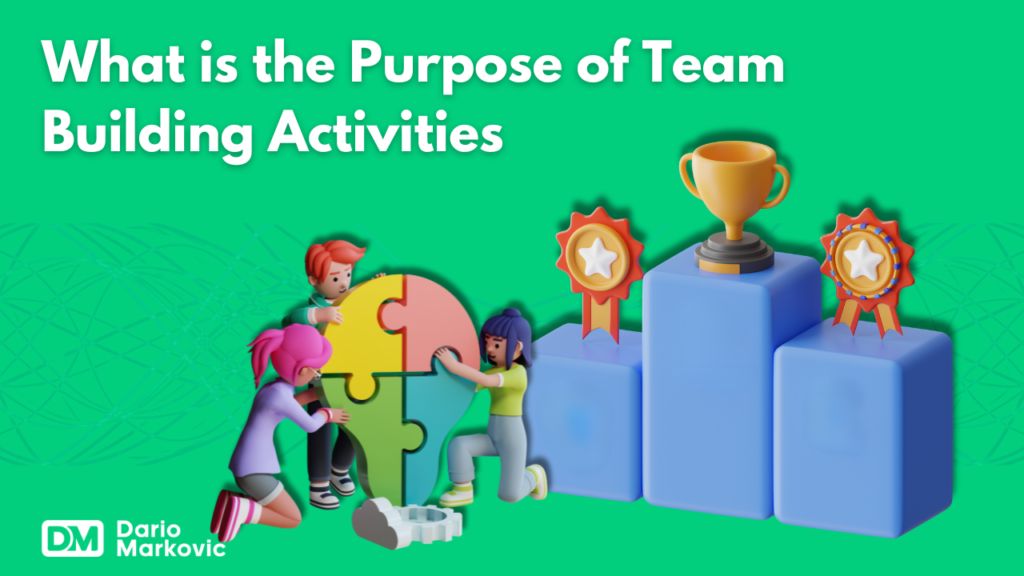What is the purpose of team building activities?
Well, they are more than just fun and games. In today’s work environment, it’s crucial to invest in a happy and productive workforce. Building a strong team is a major key to success. So, what is the purpose of team building activities, really?
It’s to create an environment where people work together harmoniously and effectively, maximizing their potential as a unit.
Imagine a basketball team where players don’t pass the ball or strategize. It would be chaos, right? That’s why team building matters. It’s about fostering those essential elements of trust, communication, and collaboration to avoid that chaotic basketball game scenario and turn your team into a well-oiled machine.

Why Team Building is Important?
Forbes notes that team building is the “most important investment you can make for your people.” Investing time in team building activities helps create a positive work environment, build trust, and increases productivity.
Companies with strong company cultures tend to have happier employees. One way companies can build strong and positive company cultures is to engage in regular team building.
What Are Types of Team Building Activities?
Team building comes in various forms. They’re designed to address common workplace challenges in a more relaxed, engaging setting.
Understanding your team’s specific dynamics and goals is critical when selecting the right team building activities to achieve a common goal.
1. Communication-Focused Activities
Think of these activities as a way to fine-tune your team’s communication skills. They are designed to improve verbal and nonverbal communication.
Imagine a game of telephone – how the original message gets distorted as it’s passed along highlights the importance of clear and effective communication. This type of team building exercise can be great for team development and improving team cohesion.
| Activity | Objective |
|---|---|
| Team Bonding Workshops Using the emotional culture deck | This workshop, which can be run in under 3 hours, can significantly enhance team communication and team bonding skills by helping your team define and improve their working relationships as well as the overall emotional culture of your team. |
| Escape Room Challenges | Require clear communication under pressure. Imagine teams deciphering clues and solving puzzles. The time crunch adds a thrilling element, encouraging teams to communicate effectively to escape before time runs out. |
2. Trust-Building Activities
These activities foster trust among colleagues, and remember, trust is the foundation of any solid relationship. These trust building games often involve scenarios where team members need to rely on each other to succeed.
Activities such as trust falls are great for building trust and dependability amongst teammates. Blindfolded obstacle courses are another way teams can learn to work together, as blindfolded team members have to depend on their seeing teammates to successfully guide them through the course.
3. Problem-Solving Activities
Just like the name suggests, problem-solving activities center around teams coming together to find solutions. These exercises encourage creative thinking and promote a collaborative approach to problem solving.
Playing Scavenger hunts are a perfect illustration. Teams decipher clues and solve puzzles to find hidden treasures. This requires brainstorming, critical analysis, and working as a unit to achieve the goal.
4. Decision-Making Activities
Decision-making activities mimic real-life scenarios where teams need to reach a consensus. Engaging in role-playing, analyzing hypothetical situations, and making choices together are great examples.
What Are the Benefits of Team Building Activities?
Indeed highlights several benefits of team building, including:
- Improved Communication
- Enhanced Collaboration
- Stronger Trust
- Reduced Conflicts
- Increased Productivity
- Greater Job Satisfaction
- Boosted Morale
- Unlocking Leadership
When thoughtfully planned, these activities translate into real improvements. Remember that successful team building isn’t a one-time fix; it’s an ongoing process.
A good team building program should be incorporated into the regular work schedule.
Key Considerations for Avoiding Mistakes During Team Building
While team-building activities can do wonders, there are common pitfalls to avoid. If you’ve ever experienced a poorly planned team-building event, you’ll understand.
First and foremost, you need to identify your team’s needs, the goals you aim to achieve, and how you’ll measure success.
One of the biggest mistakes? Not having a clear objective. Just like any good marketing campaign or business plan, a well-defined objective is key. Without one, you’re essentially a ship sailing without a destination in mind.
Clearly outline what you hope to achieve – better communication, improved problem-solving, or stronger team relationships?
Dario's Summary
So, let’s bring it back to the main question: what is the purpose of team building activities?
They’re a valuable investment for any team aiming for success. They improve productivity and communication while boosting morale, job satisfaction, and innovation. It’s about fostering a cohesive, high-performing team.
Through carefully planned team building exercises and a clear understanding of your team’s specific needs, your team can really unlock their true potential.
Frequently Asked Questions
The main objective is to improve team performance and productivity. They’re about fostering a positive work environment where everyone feels valued and employee engagement increases.
These activities provide numerous advantages. Indeed.com reveals just how beneficial these can be. They can strengthen relationships, leading to smoother collaborations and a more positive and supportive company culture.
Their main purpose is to bring teams closer together. These events help cultivate strong bonds among colleagues and encourage team members to work together more efficiently. Team building exercises also foster a more collaborative and positive work environment, leading to better problem-solving, boosted creativity, and enhanced decision-making.
Ultimately, it depends on the team’s specific needs. Is communication an issue? Focus on activities that foster dialogue and improve communication. Looking to build trust? Incorporate activities that emphasize vulnerability. The chosen exercises should always cater to those areas. Remember to continuously reassess your team’s dynamics. It will ensure your team building efforts remain relevant and impactful.



